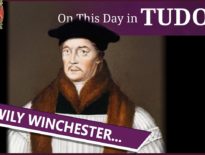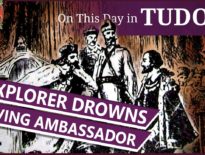On this day in Tudor history, 11th November 1534, Philippe de Chabot, Seigneur De Brion and Admiral of France, landed on English soil. The purpose of the diplomatic mission he was leading was to renew Anglo-French relations.
George Boleyn, Lord Rochford, brother of Queen Anne Boleyn, had been put in charge of meeting the admiral and escorting him on his journey from the south coast to London, but it was no easy task. The admiral did not make things easy at all, and George was rather stressed about the situation.
Find out what happened, and how and why the ambassador's visit was bad news all round for the Boleyns, in today's talk.
Book recommendation - George Boleyn: Tudor Poet, Courtier and Diplomat by Clare Cherry and Claire Ridgway.
Also on this day in Tudor history, 11th November 1541, the feast of Martinmas, King Henry VIII’s council sent Archbishop Thomas Cranmer a letter containing instructions to move Queen Catherine Howard from Hampton Court Palace to Syon House, formerly Syon Abbey.
Find out more about the instructions that Cranmer was given, what the queen was sent for her time at Syon, what else happened on this day in 1541, and hear some trivia about the people in charge of Catherine's household at Syon, in last year’s video:
Also on this day in history:
- 1491 – Birth of Martin Bucer, theologian and leading reformer, at Sélestat in Alsace. Bucer was the leading reformer of Strasbourg and was influenced by Martin Luther. His works included Defensio adversus axioma Catholicum, “Von der Waren Seelsorge” (“Concerning true pastoral care”), Gratulatio ad ecclesiam Anglicanam (“Congratulation to the English church”), “Bestendige Antworten (“Steadfast response”) and De ordinatione legitima (“On restoring lawful ordination”). While in exile in England in 1549, Bucer was commissioned to review the “Book of Common Prayer”.
- 1508 – Death of Sir Edward Brampton, soldier and merchant, at Lisbon in Portugal. He had been given a licence to settle in Portugal in 1487, and was known there as Duarte Brandão.
- 1546 – Birth of Richard Madox, diarist and Church of England clergyman, in Shropshire. He is known for the diary he kept of Captain Edward Fenton's voyage to the Moluccas, while he was serving as Fenton's Chaplain and Secretary. Madox died during the voyage.
- 1563 – Burial of chronicler Henry Machyn (Machin) in London. He died after contracting the plague. Machyn is known for his chronicle “The Diary of Henry Machyn, Citizen and Merchant-Taylor of London, from A.D. 1550 to A.D. 1563”.
- 1593 – Death of Christopher Carleill, soldier and naval commander, in London. Carleill's naval and military career saw him serving in the Low Countries, France and Ireland. He also commanded the land force on Sir Francis Drake's expedition to Santo Domingo. Carleill was also known for his knowledge of mathematics, languages and his skill at poetry.
Transcript:
On this day in Tudor history, 11th November 1534, Philippe de Chabot, Seigneur De Brion and Admiral of France, landed on English soil at Dover. The purpose of the diplomatic mission he was leading was to renew Anglo-French relations.
As Clare Cherry and I point out in our biography of George Boleyn, England had become “more and more isolated from her European cousins” due to Henry VIII’s annulment of his marriage to Catherine of Aragon, his break with Rome and his marriage to Anne Boleyn, so this French embassy was hugely significant.
George Boleyn, Lord Rochford, brother of Queen Anne Boleyn and one of Henry VIII’s leading courtiers, was entrusted by the king to escort and entertain the Admiral on his journey from the English coast to London. It was a huge undertaking because it wasn’t just the Admiral George was in charge of, it was also his train of men and 350 horses. Poor George was expected to get the Admiral to London as quickly as possible, but the Admiral’s train caused problems.
“Letters and Papers” includes letters from George Boleyn at this time, showing just what an administrative nightmare this visit was. George was worrying about it even before the Admiral arrived, writing the following letter to Lord Lisle in Calais:
“I have sent the bearer, the King’s servant, only to bring me sure word in what sort the Admiral will cross the sea, and whether he will send his train before him or come first himself. I beg you to inquire and send word by the bearer, and that he may have the first passage after the Admiral has arrived at Calais. Vaghan, the bailly of Dover, whom you have required to come to Calais as one of the retinue there, cannot be spared, as the Admiral is lodged in his house. Commend me to my lady. Dover, 6 Nov.”
Then, on the 11th November 1534, we have a letter from George to his uncle, the Duke of Norfolk, who was also involved in the Admiral’s travel arrangements:
“The Admiral arrived this day at 10 o’clock. I and such as were commanded to attend met him at his landing, and brought him to Dover. Next day he goes to Canterbury, where he wishes to stop all day, that his train may meet him. I have sent the King the names of all of them. You shall be sure to hear from me from Canterbury. Dover, 11 Nov.”
The Admiral had landed, but he obviously wanted to wait for his train.
Then, on the 14th November, George wrote to Henry VIII explaining the delay and the plans for the journey. George was obviously worried about what the King would think and irritated by how things were going. He needed to explain that the delay was not to any incompetence on his part:
“It may please your highness to be advertised, that the admiral of France hath remained here since Thursday at night, and as yet his whole train both of horses, mules and men, be not come hither nor unshipped. But by tomorrow I doubt not but all his whole train shall be here assembled together: and upon Monday, I will bring him to Sittingbourne, there to remain that night, for that it would be too sore a journey to bring his carriage to Rochester in a day. On Tuesday from thence to Rochester. On Wednesday to Dartford; and on Thursday, by 12 o’clock at noon, to Blackheath; where as my Lord of Norfolk is appointed by your grace to meet him. I would not have him remain so long in this town, but that himself was very desirous so to do, because that he would come with his train whole together, which I thought might not for your graces honour gain saye. And thus, beseeching God to have your highness in his keeping, I make an end.
From Canterbury, this 14th day of November
Your graces most humble and obedient subject
and servant,
GEORGE ROCHEFORD”
According to Chapuys’ reports to Charles V, the Admiral finally arrived in London on the 17th November. Chapuys explained that he was held up because he had to wait for his train to cross the Channel, and also “to give leisure to those here to make the necessary preparations for his reception”. Chapuys also reported on what the Admiral discussed with the King, and it was not good news for the Queen and the Boleyn faction. Although the King’s Council had “made propositions for the marriage of the King’s second daughter”, i.e. Anne’s daughter, Elizabeth, Chapuys wrote of how “opinions” had been collected in France, Italy and other parts of Europe, and that it was generally thought “that even if the King’s first marriage were invalid, the Princess was still legitimate, and the succession belonged to her”. Europe still saw Mary as legitimate and above Elizabeth in the line of succession.
Anne Boleyn was not amused, and Chapuys recorded her as being “very angry at it”. Henry VIII countered by offering Elizabeth in marriage to the Duke of Angoulême, Francis I’s third son, but that just wasn’t the same as marriage to the Dauphin, Francis I’s heir, and the French rejected this offer anyway.
As Clare Cherry and I point out in our book on George, “the French stance shocked both Anne and her brother, who had previously thought that any support they may have received from abroad would be from France.”
George had left the French king on excellent terms in July 1534, so what was going on?
Well, in October 1534, just a month before the Admiral’s visit, there had been the Affair of the Placards where anti-Catholic posters had been put up around Paris, Blois, Rouen, Tours and Orléans, and even on the door of Francis I’s bedchamber at the Château d’Amboise. This had completely turned the French king against the evangelical movement and, of course, the Boleyns were closely associated with the reformed faith. “From being tolerant of Reform, and a potential ally of the Boleyns, Francis had come to distrust the very ideals that they embodied” and he preferred to arrange a marriage between his son and the Catholic Mary.
Anne may have been shocked and angered by what happened when the king and Chabot met, but historian Eric Ives writes that “Anne nevertheless did her best to improve matters” towards the end of the Admiral’s visit by entertaining him at a final lavish banquet.



Your book on George Boleyn is one of my favorite books about the Tudor era. Very informative. Its in my keep forever pile! Michelle t
That’s lovely to hear, Michelle, thank you!